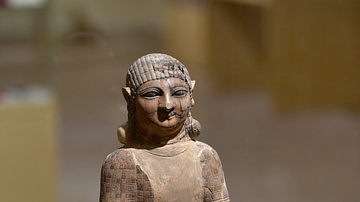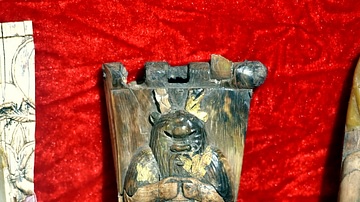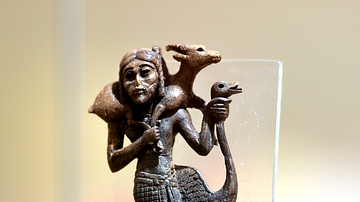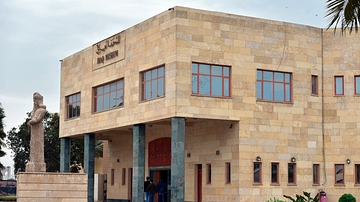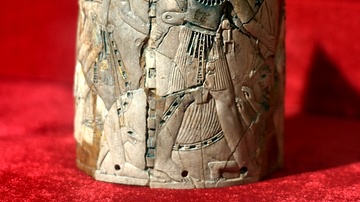Illustration
These three frontlets were found inside Well AJ at the North-West Palace at Nimrud (in modern-day Nineveh Governorate, Iraq). They are part of the so-called "Classical Phoenician" hinged frontlets of Group 2.
The middle frontlet depicts a central male (deity) figure, wearing a solar disc on his head (flanked by two crowned uraei). He holds with his hand two bowls on which two deities are seated and hold a lotus stem. The central figure is flanked by cartouches (topped by a double-plumed solar disc) sitting on a lotus flower. The frontlet is sub-triangular in shape and the lower part ends in voluted palmette plants. There is a row of uraei at the upper margin.
The frontlets on either side represent the upper part of the hinged frontlets. A standing and winged female (goddess) figure wears the Hathor crown on a lappet wing and holds atum feathers in her hands. They are triangular in form, also ending in voluted palmette plants. The lower edge has a row of uraei.
Some of the gold overlay is still present on these frontlets. Neo-Assyrian period, 911-612 BCE. They are on display at the Nimrud Ivories Gallery of the Iraq Museum in Baghdad, Republic of Iraq.
About the Author
Cite This Work
APA Style
Amin, O. S. M. (2019, March 21). Ivory Horse Frontlets from Nimrud. World History Encyclopedia. Retrieved from https://www.worldhistory.org/image/10287/ivory-horse-frontlets-from-nimrud/
Chicago Style
Amin, Osama Shukir Muhammed. "Ivory Horse Frontlets from Nimrud." World History Encyclopedia. Last modified March 21, 2019. https://www.worldhistory.org/image/10287/ivory-horse-frontlets-from-nimrud/.
MLA Style
Amin, Osama Shukir Muhammed. "Ivory Horse Frontlets from Nimrud." World History Encyclopedia. World History Encyclopedia, 21 Mar 2019, https://www.worldhistory.org/image/10287/ivory-horse-frontlets-from-nimrud/. Web. 17 Apr 2025.



